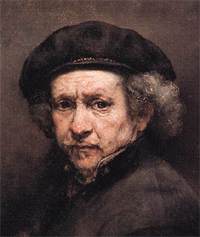
Rembrandt was born in Leiden on July 15, 1606- his full name Rembrandt Harmenszoon van Rijn. He was the son of a miller. Despite the fact that he came from a family of relatively modest means, his parents took great care with his education. Rembrandt began his studies at the Latin School, and at the age of 14 he was enrolled at the University of Leiden. The program did not interest him, and he soon left to study art - first with a local master, Jacob van Swanenburch, and then, in Amsterdam, with Pieter Lastman, known for his historical paintings. After six months, having mastered everything he had been taught, Rembrandt returned to Leiden, where he was soon so highly regarded that although barely 22 years old, he took his first pupils. One of his students was the famous artist Gerrit Dou.
Rembrandt moved to Amsterdam in 1631; his marriage in 1634 to Saskia van Uylenburgh, the cousin of a successful art dealer, enhanced his career, bringing him in contact with wealthy patrons who eagerly commissioned portraits. An exceptionally fine example from this period is the Portrait of Nicolaes Ruts (1631, Frick Collection, New York City). In addition, Rembrandt's mythological and religious works were much in demand, and he painted numerous dramatic masterpieces such as The Blinding of Samson (1636, Städelsches Kunstinstitut, Frankfurt). Because of his renown as a teacher, his studio was filled with pupils, some of whom (such as Carel Fabritius) were already trained artists. In the 20th century, scholars have reattributed a number of his paintings to his associates; attributing and identifying Rembrandt's works is an active area of art scholarship.
In contrast to his successful public career, however, Rembrandt's family life was marked by misfortune. Between 1635 and 1641 Saskia gave birth to four children, but only the last, Titus, survived; her own death came in 1642- at the age of 30. Hendrickje Stoffels, engaged as his housekeeper about 1649, eventually became his common-law wife and was the model for many of his pictures. Despite Rembrandt's financial success as an artist, teacher, and art dealer, his penchant for ostentatious living forced him to declare bankruptcy in 1656. An inventory of his collection of art and antiquities, taken before an auction to pay his debts, showed the breadth of Rembrandt's interests: ancient sculpture, Flemish and Italian Renaissance paintings, Far Eastern art, contemporary Dutch works, weapons, and armor. Unfortunately, the results of the auction - including the sale of his house - were disappointing.
These problems in no way affected Rembrandt's work; if anything, his artistry increased. Some of the great paintings from this period are The Jewish Bride (1665), The Syndics of the Cloth Guild (1661, Rijksmuseum, Amsterdam), Bathsheba (1654, Louvre, Paris), Jacob Blessing the Sons of Joseph (1656, Staatliche Gemäldegalerie, Kassel, Germany), and a self-portrait (1658, Frick Collection). His personal life, however, continued to be marred by sorrow. His beloved Hendrickje died in 1663, and his son, Titus, in 1668- only 27 years of age. Eleven months later, on October 4, 1669, Rembrandt died in Amsterdam.